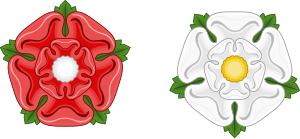
Back معركة ستوكفيلد Arabic Bitva u Stoke Czech Brwydr Maes Stoke CY Slaget ved Stoke Field Danish Schlacht von Stoke German Batalla de Stoke Field Spanish نبرد استوک فیلد FA Bataille de Stoke French Stoke Field-i csata Hungarian Battaglia di Stoke Field Italian
| Battle of Stoke Field | |||||||
|---|---|---|---|---|---|---|---|
| Part of the Wars of the Roses | |||||||
 | |||||||
| |||||||
| Belligerents | |||||||
|
|
| ||||||
| Commanders and leaders | |||||||
|
Henry VII Earl of Oxford Duke of Bedford Earl of Shrewsbury Baron Strange Baron Scales Sir John Savage |
Earl of Lincoln † Viscount Lovell Sir Thomas FitzGerald † Martin Schwartz † | ||||||
| Strength | |||||||
| 12,000 | 8,000 | ||||||
| Casualties and losses | |||||||
| 300–3,000 | 4,000 | ||||||
The Battle of Stoke Field, which took place at East Stoke, Nottinghamshire, on 16 June 1487, may be considered the last battle of the Wars of the Roses, since it was the last major engagement between contenders for the throne whose claims derived from descent from the houses of Lancaster and York. The Battle of Bosworth Field, two years previously, had established Henry VII on the throne, ending the last period of Yorkist rule and initiating that of the Tudors. The Battle of Stoke Field was the decisive engagement in an attempt by leading Ricardian Yorkists to unseat the King in favour of the pretender Lambert Simnel.[3]
Though it is often portrayed as almost a footnote to the major battles between York and Lancaster, it may have been slightly larger than Bosworth, with much heavier casualties, possibly because of the terrain which forced the two sides into close, attritional combat. In the end, though, Henry's victory was crushing. Almost all the leading Yorkists were killed in the battle.
- ^ Horrox, Rosemary (2020). Richard III: a failed king?. Penguin monarchs. London: Allen Lane. p. 73. ISBN 978-0-14-197893-2.
- ^ Horrox, Rosemary (2020). Richard III: a failed king?. Penguin monarchs. London: Allen Lane. p. 73. ISBN 978-0-14-197893-2.
- ^ Horrox, Rosemary (2020). Richard III: a failed king?. Penguin monarchs. London: Allen Lane. p. 73. ISBN 978-0-14-197893-2.